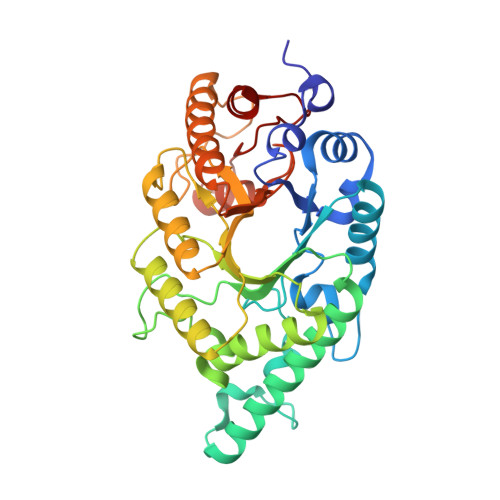Structural insights into N-terminal to C-terminal interactions and implications for thermostability of a (beta/alpha)8-triosephosphate isomerase barrel enzyme
Mahanta, P., Bhardwaj, A., Kumar, K., Reddy, V.S., Ramakumar, S.(2015) FEBS J 282: 3543-3555
- PubMed: 26102498
- DOI: https://doi.org/10.1111/febs.13355
- Primary Citation of Related Structures:
4QCE, 4QCF, 4QDM - PubMed Abstract:
Although several factors have been suggested to contribute to thermostability, the stabilization strategies used by proteins are still enigmatic. Studies on a recombinant xylanase from Bacilllus sp. NG-27 (RBSX), which has the ubiquitous (β/α)8 -triosephosphate isomerase barrel fold, showed that just a single mutation, V1L, although not located in any secondary structural element, markedly enhanced the stability from 70 °C to 75 °C without loss of catalytic activity. Conversely, the V1A mutation at the same position decreased the stability of the enzyme from 70 °C to 68 °C. To gain structural insights into how a single extreme N-terminus mutation can markedly influence the thermostability of the enzyme, we determined the crystal structure of RBSX and the two mutants. On the basis of computational analysis of their crystal structures, including residue interaction networks, we established a link between N-terminal to C-terminal contacts and RBSX thermostability. Our study reveals that augmenting N-terminal to C-terminal noncovalent interactions is associated with enhancement of the stability of the enzyme. In addition, we discuss several lines of evidence supporting a connection between N-terminal to C-terminal noncovalent interactions and protein stability in different proteins. We propose that the strategy of mutations at the termini could be exploited with a view to modulate stability without compromising enzymatic activity, or in general, protein function in diverse folds where N and C termini are in close proximity. The coordinates of RBSX, V1A and V1L have been deposited in the PDB database under the accession numbers 4QCE, 4QCF, and 4QDM, respectively.
- Department of Physics, Indian Institute of Science, Bangalore, India.
Organizational Affiliation:



















